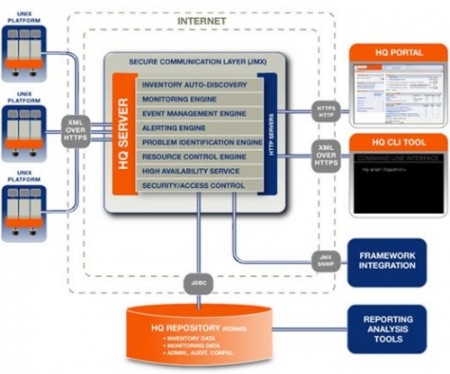Hyperic HQ Enterprise Monitoring Monitoring System
 The latest release of "goodies" from the world of open source projects hosted on SourceForge.net. This time I drew attention to a solid and serious development, claiming a corporate level of application, which, of course, does not deprive it of its attractiveness in other segments where similar opportunities are required.
The latest release of "goodies" from the world of open source projects hosted on SourceForge.net. This time I drew attention to a solid and serious development, claiming a corporate level of application, which, of course, does not deprive it of its attractiveness in other segments where similar opportunities are required.This is a monitoring system Hyperic HQ , which is designed to provide continuous and complete control over the entire IT infrastructure. It can be used in data centers and hosting companies, to monitor their own servers within the company, for startups where maximum availability and prompt response to the problems that arise are needed and important.
The system implements four common functions:
- Inventory - allows you to make an inventory of everything that is in your network, for which, in fact, you need to follow. These are physical servers and software - the operating system, servers and services.
- Monitor - tracking the current state of services and servers in real time, as well as automatic detection of deviations, saving and analyzing historical data to identify problem areas of the infrastructure.
- Alert is a notification subsystem about problems on resources that are being monitored, as well as on the elimination of errors. Notifications can be sent to the administrator either to an e-mail or to a mobile phone or pager.
- Control is both centralized service management, such as server rebooting, resource management, and other specific functions.

')
The system architecture is flexible and based on service modules, the exchange between which is based on open standards, such as HTTP / HTTPS and XML. Information about the state of the studied platforms is collected by agents that are installed on each server that need to be monitored, then all information is collected in a central server, and then stored in a permanent repository. The remaining modules implement a web portal for real-time tracking, management via the console. The analytics module, which uses data directly from the data repository, works separately. By the way, the central HQ server can be clustered to work in large networks and provide fault tolerance, and the data repository is based on the database with which the application works through JDBC, which means you can use different balancing technologies and build a fully fault-tolerant system.
HQ works on different platforms, so even if you have a very heterogeneous architecture and you use a huge number of servers and different platforms at the same time, you can use a single monitoring and management system, collecting data from any network devices. Even if you are using virtualization, based on VMware or Xen, these systems can also be connected to the monitoring system and to be monitored like any other.
More details:
- Project page
- Official site
- Hyperic HQ Overview
- System architecture
- Platform: any
- Language: Java
- License: GPL
Source: https://habr.com/ru/post/24854/
All Articles